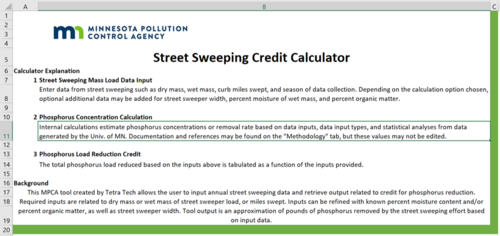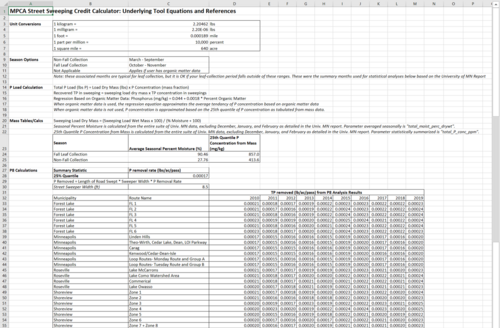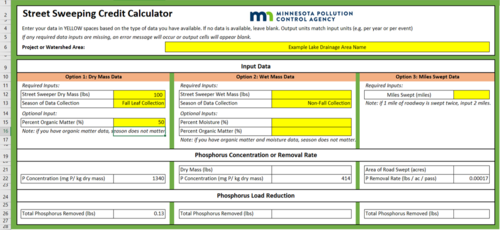
Street Sweeping Phosphorus Credit Calculator: User Guide Revision as of 16:40, 8 March 2021 by Mtrojan (talk | contribs) (→Appendix A: Credit Calculator Technical Reference)
Contents
This page provides guidance that accompanies a Phosphorus Street Sweeping Credit Calculator (Calculator).
The Calculator is an Excel workbook developed by Tetra Tech for MPCA based research and guidance compiled by the University of Minnesota and evaluations of Program for Predicting Pollution Particle Passage through Pits, Puddles, and Ponds (P8) urban catchment model results conducted by Tetra Tech using the same street sweeping data collected by the University of Minnesota. The Calculator has three tabs, two of which are informational (“Read Me” and “Methodology”), and one of which is for data entry and output (“Calculator”). Below is a description of the information on each of these three tabs, how different types of data may be input, and how to interpret output from the Calculator.
Read Me tab
The Read Me tab is the first tab at the bottom of the workbook. It provides introductory text for the Calculator, including an explanation of inputs and outputs and the background of the tool development. Data entry options for the Calculator are based on 3 different data types.
- Dry mass
- Wet mass
- Miles swept
Calculator output is described as the phosphorus load reduced based on the inputs provided. For example, if a single sweeping event is entered into the Calculator, the result is the amount of phosphorus reduced from sweeping “for that event”, whereas if the data from an entire season is entered into the Calculator, the result is the amount of phosphorus reduced “for that season”.
This tab is “locked” so the user may not change any values or text on this tab.
Methodology tab
The Methodology tab is the third tab on the Calculator workbook. It contains the reference information used by the equations on the Calculator tab. The details in this tab may be helpful for the user to understand the assumptions built into the Calculator. Information on this tab includes the following:
- Unit Conversions: Unit conversions used in the Calculator are hard linked here
- Season Options: The University of Minnesota data analysis found there are distinct patterns and relationships between nutrient concentrations and swept material that occur seasonally due to when leaf-fall typically occurs. The calculator has two options for season. Fall Leaf Collection season is based on the University of Minnesota sweeper data from October through November. The Non-Fall Collection season is based on the sweeper data from March through September (winter months were not included in the study). The user should select the most appropriate season based on when sweeping occurred. For example, if leaf drop occurred late in the season, and early October sweeping activities were not collecting fall leaves, the user can select Non-Fall Collection for these events to better reflect the materials swept. If the user has data for organic matter and enters this into the Calculator worksheet, the season of collection is not used for the equations in the Calculator. The University of Minnesota found that phosphorus is statistically better correlated to the percent organic matter than the season, so a separate statistical relationship is used when these data are available.
- P Load Calculation: Specific information related to how phosphorus load reductions are calculated, including regressions from the U of M study.
- Mass Tables/Calcs: Presentation of how sweeper load dry mass is calculated from sweeper load wet mass and percent moisture concentration as documented by the University of Minnesota. The seasonal average percent moisture and seasonal 25th quantile phosphorus concentration from mass are presented as they are used in the Calculator tab depending on the season and the type of data input.
- P8 Calculations: Calculation of the 25th quantile estimation of phosphorus removal rate developed by P8 model results, as well as presentation of phosphorus load reduction equation as it relates to length of road swept, sweeper width, and phosphorus removal rate. The statistical analysis associated with the P8 phosphorus removal rate was based on ten years of simulation across 4 municipalities and 23 routes. The P8 model was set up according to the parameterization recommended by MPCA in the Recommendations and Guidance for Utilizing P8 to Meet TMDL Permit Requirements.
This tab is “locked” so the user may not change any values or text on this tab.
Calculator tab
The Calculator tab is the second tab in the workbook. It is the worksheet where users enter street sweeping information and phosphorus reductions are calculated. On this tab, yellow cells may be modified by the user, but all other cells are “locked” so the user may not change values or text.
At the top of the worksheet the user can provide a name and/or description of the project or watershed area. (for example “Fall Sweeping Data for Municipality A”, or “June 10th, 2020 Sweeping Event for Municipality B”).
In the Input Data section on this tab, the user may input data based on 3 different data type options, as described below.
Option 1: Dry Mass
The user enters the known dry mass of materials swept for their period of interest. The season must also be provided if there is no organic matter data, due to the various equations used to calculate phosphorus concentration. If the percent organic matter is used as an input, “Not Applicable” must be selected for the Season of Data Collection.
The default phosphorus concentration based on the selected season or percent organic matter is displayed in Row 22 and the resulting pounds of phosphorus removed is shown in Row 26.
For guidance on collection, measurement and analysis of street sweepings, wee Methods for sampling street sweeping material - Standard Operating Procedures.
Option 2: Wet Mass
This option should be used when the dry mass has not been determined. The user enters the known wet mass and selects a season, if the percent organic matter is unknown. The user may optionally include the percent moisture and/or the percent organic matter, if one or both values is known. Otherwise seasonal average assumptions will be applied based on University of Minnesota data.
The resulting dry mass and phosphorus concentration, based on the user inputs, are shown in Rows 21 and 22. The resulting pounds of phosphorus removed is shown in Row 26.
For guidance on collection, measurement and analysis of street sweepings, wee Methods for sampling street sweeping material - Standard Operating Procedures.
Option 3: Miles Swept
This option should be used if no information is available on the mass of sweeper material collected. The user enters the miles swept. Multiple passes on a given roadway should be counted separately. For example, if one lane of a road is swept for 2 miles in the eastbound direction and one lane of the same road is swept for 2 miles in the westbound direction, 4 miles swept should be entered. Similarly, if 2 miles of the eastbound lane are swept 3 times during the data calculation period, 6 miles should be entered. For inputs of miles of roadway swept, there is no required input for season.
The Calculator will calculate the resulting acres of roadway swept and apply the default phosphorus removal rate. The resulting pounds of phosphorus removed is provided in Row 26.
The Calculator can be used after any street sweeping event to calculate phosphorus removal from individual sweeping events or sweeping data can be aggregated outside of the Calculator and summary data entered in the Calculator to provide phosphorus removal for multiple sweeping events over the course of a season in a single calculation.
Appendix A: Credit Calculator Technical Reference
Methodology and technical justification for the equations and relationships incorporated into the MPCA Street Sweeping Credit Calculator are summarized here.
The mass-based approach for street sweeping credit is backed by research-based empirical relationships developed using research conducted by the University of Minnesota Water Resources Center (the University). The University research involved evaluating relationships among wet mass, dry mass, organic carbon content, and phosphorus concentrations of collected sweeper loads for five cities. Three sweeper types (regenerative air, mechanical broom, and vacuum) were used to conduct street sweeping, and collection occurred throughout the snow-free season (April – November). Data relationships were derived from existing data from the Prior Lake Street Sweeping Study (Kalinosky et al., 2013a; Kalinosky, 2015).
Including the Prior Lake data, samples were collected from 37 sweeping routes across the snow-free season for 2010-2012 (Prior Lake) and 2019 for the remaining four cities. This yielded 384 samples from Prior Lake and 191 total samples from remaining cities. Samples were processed and analyzed at the University of Minnesota’s Department of Ecology, Evolution and Behavior using methods developed in the Prior Lake Street Sweeping Study and described in detail in Kalinosky et al. (2014).
Following sample analyses, the data were analyzed using mixed linear models to determine whether moisture content, organic content, and carbon and phosphorus concentrations of the sweeper loads vary based on factors such as canopy cover and season. Two final reports summarizing the findings of the study were completed and the data relationships documented were used in developing the MPCA crediting methodology. The University provided approaches for approximating phosphorus removed from street sweeping based on inputs such as sweeper dry mass, wet mass, percent moisture, and/or percent organic matter.
Equations for creating the Calculator
MPCA, Tetra Tech, and the University explored various potential crediting options based on the anticipated predictive relationships that would be derived from the University research. The group explored several methods of calculating phosphorus reduction credits, expressed as pounds reduced per year from street sweeping and selected options which balanced the amount of data that a permittee would need to collect and the predictive error in the statistical relationship with phosphorus concentration.
The statistical relationships developed by the University and employed in the Calculator are related to potential inputs of dry mass, wet mass, percent organic matter, and/or percent moisture to derive phosphorus reduction credits. The minimum data requirements for the Calculator are either dry or wet mass and sweeping season.
The crediting method using miles swept was derived from Tetra Tech’s analysis of phosphorus reductions using the MPCA recommended default setup for the P8 model with inputs derived from the University’s sweeping study. This option was developed for jurisdictions without the capacity to collect the more detailed data required to derive the phosphorus removal rate using the University’s statistical relationships. If a user chooses to input miles swept, the reductions are significantly less than would be expected from the methods based on the amount of sweeper material collected because this is a coarser method of estimating phosphorus removal.
After input of available street sweeping data, the Calculator uses the equations summarized below and statistical methods developed by the University to estimate the amount of phosphorus reduced due to the street sweeping effort.
The relationship between seasonality and phosphorus was incorporated into the Calculator. Based on the data from the University, there is a pronounced difference in both moisture content and phosphorus concentration depending on the season. The Calculator is designed to represent two periods of street sweeping throughout the year, fall leaf collection and non-fall collection. The default values for the non-fall collection period were derived from data from March through September, and the values for the leaf collection period were derived from the data from October and November.
This distinction allows permittees the ability to report with greater accuracy whether leaf collection was a major component of sweeping, and also allows the flexibility to report leaf collection when it actually occurs, rather than being tied to a specific month, e.g., if leaf drop is early one year, the leaf collection values could be applied to September collections, or if leaf drop is late, the non-fall collection values could be applied in October. In general, any street sweeping that occurs in December through August could be assumed to be part of a non-fall collection period. Because the Calculator is fundamentally based on the amount of street swept and the amount of materials collected, it provides municipalities the flexibility to calculate reductions on an annual basis, or on other metrics, such as monthly, seasonally or by sweeper route or date of collection. This allows jurisdictions who choose to collect more advanced data on their sweeper program to evaluate the results at a finer scale and determine the crediting method that is advantageous to their program.
The equations and methods employed in the Calculator are brought forward from the University documentation. The following section details the options for data input and underlying equations.
Note that the choice was made to use the 25th quantile statistic relative to a number of parameters from the research dataset. This choice was made because the Calculator is intended to be applied statewide; however, data were collected in one of the most urban areas of the state in and around Minneapolis. By using the 25th quantile of particular parameters (e.g. observed phosphorus concentration), the Calculator is able to provide an estimate for phosphorus reduction that is generally conservative, and thus provide a margin of safety to estimated reductions, given that statewide or regionally-specific dataset were not available to develop the statistical relationships.
Option 1: Dry Mass Data
For inputs of sweeper dry mass data, the load of phosphorus removed from the sweeping event is a function of the mass fraction of phosphorus concentration in that load:
Phosphorus Removed=Dry Mass ×Phosphorus Concentration (Equation 1)
The phosphorus concentration applied in the Calculator was calculated as the 25th quantile of all observed concentrations relative to dry mass load data compiled by the University, which was found to be statistically different based on the season collected because fallen leaves produce readily available nutrients in roadways (Table 1).
Table 1. Seasonally derived phosphorus concentration calculated from the University sampling dataset Season 25th Quantile Phosphorus Concentration from Mass (mg/kg) Fall leaf collection 857.0 Non-fall collection 413.6
The phosphorus concentration applied for the fall leaf collection season is 857.0 mg/kg, and for the non-fall collection season is 413.6 mg/kg. If percent organic matter is measured along with sweeper dry mass data, the phosphorus concentration applied by the Calculator is a function of percent organic matter rather than a function of season collected:
Phosphorus Concentration=0.044+0.0018×Percent Organic Matter (Equation 2)
Option 2: Wet Mass Data
For inputs of sweeper wet mass data, the load of phosphorus removed from the sweeping event is a function of the phosphorus concentration and a conversion of the wet mass to an approximate dry mass.
Dry Mass=((Wet Mass×100) )⁄((Percent Moisture+100)) (Equation 3)
If the percent moisture is known, that may be input into the equation above directly, otherwise a seasonally averaged percent moisture developed from the University dataset is applied (Table 2).
Table 2. Seasonally derived percent moisture calculated from the University sampling dataset Season Average Percent Moisture (%) Fall leaf collection 90.46 Non-fall collection 27.76
If the percent organic matter of the wet mass is known, the phosphorus concentration as a function of percent organic matter (see Equation 2), otherwise seasonally dependent concentrations are applied (see Table 1).
Option 3: Miles Swept Data
If there is no mass data collected and the only available data is miles swept, the Calculator approximates phosphorus load reduction as a function of areal removal determined using P8 model results. This option is the least precise method as the actual dynamics associated with street sweeping may vary widely (e.g., sweeper type, parking on the route, time of year, frequency of sweeping). Tetra Tech obtained sweeping route information from the University and applied the P8 model to the sweeping frequencies and routes for a 10-year period to capture varying precipitation conditions. The results of the modeling effort are detailed in full in a separate memorandum.
The Calculator calculates phosphorus removal from miles swept as a function of areal phosphorus removal, and area swept:
Phosphorus Removed=Length Swept×Sweeper Width×Areal Phosphorus Removal (Equation 4)
The 25th quantile statistic of areal phosphorus removal is 0.00017 pounds per acre per pass as calculated from all P8 modeling data and routes simulated. The area swept is calculated using an average assumed street sweeper width of 8.5 feet, although it should be noted that the vast amount of sediment removal from street sweepers occurs directly along the curb and gutter.
The P8 model used to calculate the phosphorus removal rate relied on MPCA recommended default values for particle fraction size distribution and total suspended solids concentrations and results in a substantially lower removal rate that the other methods.


